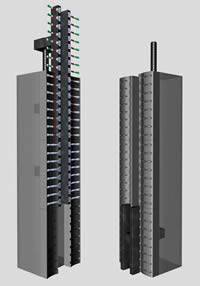Compact Solution for Two-Component Molding
Zahoransky’s new internal mold handling technology foregoes the time, space and money required for core-back, rotary table or index plate technologies for 2K molding.
Zahoransky Automation and Molds GmbH has introduced what it calls internal mold handling as an alternative for core-back, rotary table or index plate technologies normally applied for multicomponent injection molding. The company says internal mold handling enables high output in a smaller space by automatically reducing the cavity pitch distance before the second material is injected. Commercially proven, an internal mold handling tool is already used in the production of applicator caps for continuous glucose measurement devices.
This application features a special applicator so that patients can attach the device to themselves with minimal effort. Used for the correct application of the devices and for storage, the applicator is sealed with a screw cap molded using two-component injection molding with a polypropylene (PP) shell and a thermoplastic elastomer (TPE) seal. The cap’s screw thread means the parts cannot just be ejected from the mold but must be unscrewed.

Zahoransky internal mold handling allows smaller presses with less tonnage and daylight to be used for 2K injection molding applications.
Source: Zahoransky
Zahoransky said core-back or turntable methods were ruled out by the customer from the outset, noting that use of a standard index plate would have been possible but not ideal in terms of footprint and machine efficiency, as space is limited in the production hall.
To meet the challenge, Zahoransky paired its Z.Warp offering for fully automatic 2K molding, with the new internal tool handling. That system features a gripper arm, sitting on a mold-integrated handling unit, which removes the initial PP part and places it in the mold for TPE overmolding. Importantly, before the half-finished part is inserted and the second material is overmolded, the cavity pitch distance is reduced, so that at changeover, the distances between the cavities are automatically reduced or adapted to the optimum requirements. The finished caps are then removed by a six-axis robot in parallel with the injection molding process, enabling the cycle time to be significantly optimized.
Zahoransky says that in addition to technical advantages, such as minimizing mold open, this technology enables significant space and cost savings because the mold itself requires less space due to the internal handling and the required injection molding machine can also be significantly smaller.
A Zahoransky spokesperson told Plastics Technology that internal mold handling enables the tool to only open 200 mm or roughly 8 inches. Because a rotary table or index plate mold must open completely and the handling system must move between the two mold halves with the end-of-arm tool (EOAT), that setup would have required an opening stroke of approximately 400 mm or 16 inches.
The spokesperson says a 225-ton all-electric injection molding machine with 22 inches of tiebar spacing is used in production. If an index plate had been used, a press with tiebar spacing of 28 inches and 360 tons of clamp force would have been required. That shorter opening stroke plus the elimination of rotation time and removal with a closed mold enabled Zahoransky to take three seconds off the final cycle time.
The reduction of the pitch or cavity spacing enables Zahoransky to make the mold more compact and fit more cavities into the same area. The spokesperson notes this would not be possible with a conventional index plate, because the gauge must remain identical. In the case of the internal mold handling tool, the gauge is condensed by approximately 40 mm or 1.5 inches.

Zahoransky internal mold handling enabled the creation of a smaller production cell for the two-component cap. Source: Zahoransky
Related Content
Arburg Open House Emphasizes Turnkey Capabilities
Held at the company’s U.S. headquarters in Rocky Hill, Connecticut, the event featured seven exhibits, including systems that were designed, sourced and built in the U.S.
Read MoreMilacron’s Massive Booth Highlights Multiple Brands
NPE2024: Coinjection of postconsumer resin, in-mold decoration, LSR micromolding and bioplastics processing are just some of the machine displays at Milacron's booth.
Read MoreSecondary Injection Unit Provides Primary Benefits for Molder
Core Technology Molding turned to Mold-Masters E-Multi auxiliary injection unit to help it win a job and dramatically change its process.
Read MoreCoinjection Technology Showcases Recycled Material Containment
At Fakuma, an all-electric PXZ Multinject machine sandwiches a black core made of mechanically recycled PC/ABS within an outer layer made of chemically recycled ABS.
Read MoreRead Next
New Concept for Multi-Shot Molds
Production of multi-color or multi-material articles on a conventional injection press without additional equipment is enabled by new tooling technology from German moldmaker Zahoransky Formenbau GmbH.
Read MoreSee Recyclers Close the Loop on Trade Show Production Scrap at NPE2024
A collaboration between show organizer PLASTICS, recycler CPR and size reduction experts WEIMA and Conair recovered and recycled all production scrap at NPE2024.
Read MoreLead the Conversation, Change the Conversation
Coverage of single-use plastics can be both misleading and demoralizing. Here are 10 tips for changing the perception of the plastics industry at your company and in your community.
Read More


























